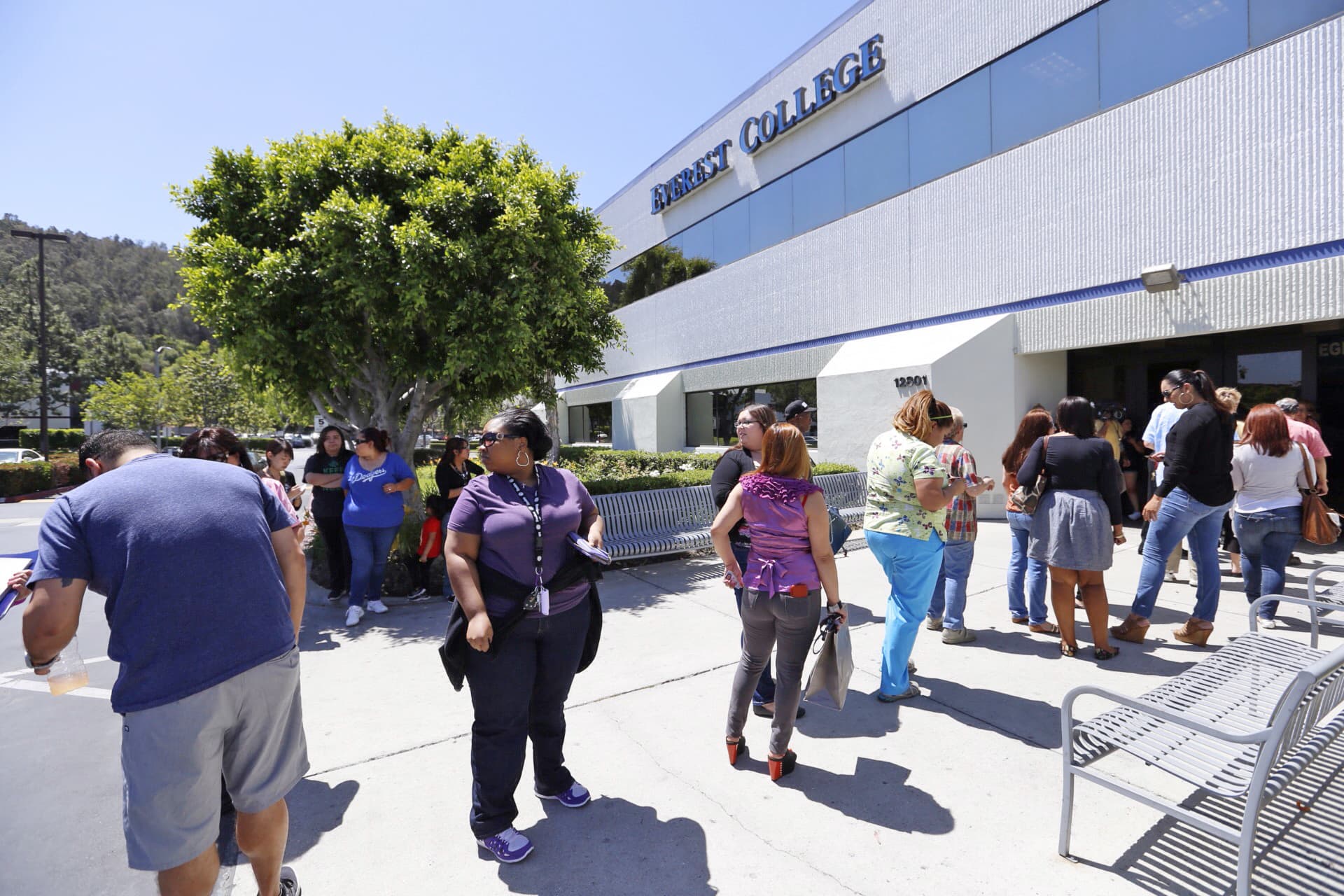Home>Finance>Reasons Why Student Loans Should Not Be Forgiven


Finance
Reasons Why Student Loans Should Not Be Forgiven
Published: January 20, 2024
Discover why forgiving student loans may not be the best solution for the finance industry. Explore the reasons behind this controversial topic and its potential impact.
(Many of the links in this article redirect to a specific reviewed product. Your purchase of these products through affiliate links helps to generate commission for LiveWell, at no extra cost. Learn more)
Table of Contents
Introduction
Student loan debt has become a pressing issue in recent years, with millions of Americans carrying the burden of educational loans long after graduation. The prospect of having these loans forgiven has gained momentum as a potential solution to alleviate this financial strain. While the idea of student loan forgiveness might seem appealing on the surface, it is important to examine the potential ramifications and consider the long-term effects.
First and foremost, it is crucial to promote financial responsibility among students. Taking out a loan to finance education is a significant decision that comes with the responsibility of repayment. By forgiving student loans, we risk sending the message that personal financial responsibility can be disregarded. This could create a culture of entitlement and undermine the importance of careful financial planning and decision-making.
Furthermore, granting widespread student loan forgiveness could create a moral hazard. Individuals who have already repaid their loans or have managed to graduate without incurring significant debt might feel slighted and unfairly treated. It is essential to consider the impact on those who made sacrifices, worked multiple jobs, or carefully managed their finances to avoid excessive borrowing.
Another aspect to consider is the potential impact on the overall economy. Student loan debt, while burdensome for individuals, also serves as a source of income for lenders and investors. Forgiving these loans could disrupt the functioning of the financial system and have wider economic implications. Additionally, without the pressure of loan repayment, graduates may be less motivated to actively contribute to the economy through increased consumer spending or entrepreneurial endeavors.
A crucial factor to take into account is the cost to taxpayers. The burden of forgiving student loans ultimately falls on taxpayers’ shoulders. The funds that would have been used for loan forgiveness could be directed towards other important areas, such as infrastructure development, healthcare, or social welfare programs that benefit a broader population. It is crucial to weigh the societal benefits of student loan forgiveness against the potential reallocation of funds that could have a more widespread impact.
Furthermore, widespread student loan forgiveness could be seen as unfair to those who did not take out loans or who chose less expensive education options. By only targeting those with student loan debt, we risk creating an unequal playing field and potentially perpetuating a cycle of borrowing rather than encouraging financial prudence.
Finally, the impact on future borrowers must be considered. If student loans are widely forgiven, it is possible that lenders will tighten their lending criteria, making it more difficult for future students to access loans. This could have serious implications for individuals who rely on loans to finance their education and limit their opportunities.
While the idea of student loan forgiveness may seem like a quick fix to a widespread problem, it is important to critically evaluate the potential consequences. Rather than a one-size-fits-all approach, alternative solutions such as income-based repayment plans, refinancing options, or increased financial education should be explored to address the burden of student loan debt in a more balanced and sustainable manner.
Financial Responsibility
One of the core arguments against student loan forgiveness is the importance of promoting financial responsibility among students. Taking out a loan to finance education is a significant decision that comes with the responsibility of repayment.
By forgiving student loans, we risk sending the message that personal financial responsibility can be disregarded. This could create a culture of entitlement and undermine the importance of careful financial planning and decision-making.
Encouraging students to consider the long-term consequences of their borrowing decisions is crucial for their financial well-being. By taking on student loan debt, individuals are making an investment in their future. They must weigh the potential benefits of higher education against the financial obligations they will face upon graduation.
Moreover, the concept of accountability is crucial for personal growth and development. By requiring students to repay their loans, we instill a sense of responsibility and foster a culture of hard work and perseverance. This mindset can translate into success not only in financial matters but also in other areas of life.
Financial responsibility extends beyond loan repayment; it encompasses the ability to budget, save, and make sound financial decisions. By encouraging students to take ownership of their financial futures, we equip them with valuable skills that will serve them well throughout their lives.
While student loan forgiveness may provide temporary relief, it fails to address the underlying issue of promoting financial responsibility. Instead of erasing the consequences of borrowing, we should focus on educating students about the long-term implications of their financial choices and provide resources to help them make informed decisions.
Implementing financial literacy programs, incorporating personal finance education into school curricula, and offering financial counseling services can empower students to make sound financial decisions. These initiatives can equip future borrowers with the knowledge and skills necessary to navigate the complexities of student loans and manage their finances responsibly.
Promoting financial responsibility not only benefits individual borrowers but also strengthens the overall economy. By encouraging prudent financial behavior, we can help individuals build better financial futures and contribute positively to their communities.
Moral Hazard
One of the significant concerns associated with widespread student loan forgiveness is the potential for creating a moral hazard. Moral hazard occurs when individuals act with less caution or take on greater risk due to the knowledge that they will not bear the full consequences of their actions.
If student loans are widely forgiven, it may send a message that there are no consequences for borrowing irresponsibly or taking on excessive debt. This could create a culture of entitlement, where individuals believe that they can make financial decisions without considering the long-term consequences.
This moral hazard can undermine the principles of personal responsibility and accountability. It may discourage individuals from making sound financial choices, such as working part-time, attending a more affordable institution, or seeking scholarships and grants to minimize the need for loans.
Furthermore, forgiving student loans could lead to feelings of unfairness and resentment among individuals who have already repaid their loans or who have managed to graduate without significant debt. These individuals may feel that their sacrifices and responsible financial behavior have gone unacknowledged and unrewarded.
In a society that values personal accountability, it is crucial to consider the impact of moral hazard. By providing blanket forgiveness for student loans, we risk undermining the principles of personal responsibility and fairness.
Instead, it is important to encourage responsible borrowing and reward individuals who have made informed financial decisions. Implementing income-driven repayment plans, where loan payments are based on income level, can offer relief for borrowers facing financial hardship. This approach ensures that individuals are still accountable for their loans while providing flexibility based on their current financial circumstances.
Ultimately, addressing the issue of student loan debt should involve finding ways to prevent moral hazard and promote responsibility. By encouraging borrowers to make informed choices and bear the consequences of their decisions, we can foster a society that values personal responsibility and financial prudence.
Stimulating the Economy
Advocates for student loan forgiveness argue that it would provide a significant economic stimulus by freeing up disposable income for borrowers. The idea is that if individuals are no longer burdened by monthly loan payments, they will have more money to spend, thereby boosting consumer spending and stimulating the economy.
While this argument may seem compelling, it is essential to analyze the potential long-term effects and consider the broader economic implications.
Firstly, it is crucial to recognize that student loan debt serves as a source of income for lenders and investors. When individuals borrow money for education, that money is ultimately circulated throughout the economy. By forgiving student loans, we would disrupt this financial flow and potentially create instability in the lending market.
Moreover, the economic stimulus argument assumes that borrowers would immediately redirect their freed-up funds into the economy. However, the reality is more complex. It is likely that borrowers would use some of the extra money to save, invest, or pay off other debts, rather than solely increasing consumer spending.
Additionally, the economic impact of forgiving student loans would disproportionately benefit those who incurred the most substantial debt burdens, such as graduate and professional degree holders. This raises questions about fairness and equity, as the lower-income individuals who did not attend college or took on less debt would not reap the same benefits.
Furthermore, student loan forgiveness fails to address the structural issues that lead to the high cost of education. Rather than providing a comprehensive solution, it serves as a band-aid for a deeper problem. It is essential to focus on addressing the root causes of rising tuition fees and exploring ways to make education more affordable, such as increasing funding for scholarships and grants or investing in vocational training.
Instead of relying solely on student loan forgiveness to stimulate the economy, alternative measures can be explored. For instance, providing targeted tax incentives or subsidies to encourage individuals to invest in higher education or start their own businesses can have a more direct impact. These initiatives can incentivize economic growth and empower individuals to contribute to the economy through entrepreneurial endeavors.
While student loan forgiveness may offer temporary relief and provide a boost in disposable income for borrowers, it is crucial to consider the long-term consequences and explore more comprehensive ways to stimulate the economy and address the underlying issues affecting higher education affordability.
Cost to Taxpayers
One of the significant concerns surrounding widespread student loan forgiveness is the cost to taxpayers. The burden of forgiving student loans ultimately falls on the shoulders of taxpayers, raising important questions about the allocation of public funds.
According to estimates, forgiving student loan debt could cost trillions of dollars, a significant sum that would need to be financed through government expenditure or increased taxes. This would divert funds that could be spent on other critical areas, such as infrastructure development, healthcare, or social welfare programs.
While the intention of student loan forgiveness may be well-intentioned, it is crucial to consider the societal benefits and the trade-offs involved. These funds could potentially be used to support initiatives that have a broader impact, such as investing in education at earlier stages, improving access to affordable healthcare, or addressing economic inequality more comprehensively.
Moreover, it is important to note that not all taxpayers would directly benefit from student loan forgiveness. This raises questions about fairness and equity as some individuals who have not taken out loans or have already repaid their debt may see little to no benefit from such a policy.
It is crucial to explore alternative solutions that can provide relief for student loan borrowers while minimizing the burden on taxpayers. Income-based repayment plans, for example, can adjust loan payments based on borrowers’ income levels, ensuring that loan repayment remains affordable without the need for widespread forgiveness.
Additionally, refinancing options can alleviate the burden of high-interest rates for borrowers, allowing them to manage their loans more effectively. By exploring these alternative solutions, we can prioritize the well-being of borrowers while taking into account the financial constraints faced by taxpayers.
It is important to strike a balance between addressing the needs of student loan borrowers and considering the broader financial implications on taxpayers. By doing so, we can ensure a fair and sustainable approach to managing student loan debt without unduly burdening taxpayers or compromising the allocation of public funds.
Unfairness to Non-borrowers
Widespread student loan forgiveness raises concerns regarding fairness and equity, particularly for individuals who did not take out loans to finance their education. While providing relief for borrowers may seem like a solution to address an immediate problem, it is crucial to consider the potential repercussions on those who did not incur student loan debt.
Non-borrowers may include individuals who chose less expensive educational options, received scholarships or grants, or made significant financial sacrifices to avoid borrowing. These individuals often prioritize financial responsibility and are more likely to choose affordable education options or work their way through school.
Forgiving student loans exclusively benefits those who made the decision to borrow, potentially creating an unequal playing field. The idea of debt forgiveness could lead to resentment from non-borrowers who did not receive the same financial relief, despite their responsible financial choices and sacrifices.
Furthermore, forgiving student loans without considering the circumstances surrounding higher education choices may inadvertently encourage future borrowers to take on excessive debt without considering more affordable alternatives. This perpetuates a cycle of borrowing rather than promoting responsible financial decision-making and consideration of the long-term consequences.
Instead of focusing solely on student loan forgiveness, solutions that address the structural issues of rising tuition fees and increased access to scholarships and grants should be explored. By promoting accessibility and affordability of education for all students, we can create a fairer system that rewards responsible financial choices and encourages individuals to make informed decisions regarding their education.
It is important to seek solutions that not only provide relief to student loan borrowers but also consider the fair treatment of those who did not borrow to finance their education. By doing so, we can ensure that the burden of student loan debt is handled in a way that is equitable for all individuals involved.
Impact on Future Borrowers
Widespread student loan forgiveness can have significant implications for future borrowers, potentially creating challenges and limitations for individuals seeking to finance their education in the future.
If student loans are widely forgiven, it is possible that lenders will become more cautious and tighten their lending criteria. This could result in stricter eligibility requirements, higher interest rates, or reduced loan amounts. As a result, future borrowers may face more difficulty accessing the funds necessary to pursue their education.
Another concern is the potential impact on the perception of education as an investment. By forgiving student loans, we risk sending the message that the responsibility of financing education rests solely on the government or other institutions, rather than personal financial decisions. This could undermine the idea that higher education is a long-term investment that requires careful consideration and planning.
Furthermore, widespread student loan forgiveness could inadvertently devalue the worth of a degree. If those who have already graduated and incurred debt are relieved of their loan obligations, it may diminish the perceived value of a degree for future graduates who are still required to repay their loans. This could have implications for the job market and the earning potential of individuals with student loan debt.
Instead of focusing solely on loan forgiveness, it is important to explore alternative solutions that address the root causes of the student loan debt crisis. This could involve measures such as implementing income-driven repayment plans, providing financial education to future borrowers, or advocating for increased access to scholarships and grants.
Additionally, promoting transparency in college costs and outcomes can help future borrowers make more informed decisions when selecting an educational institution. By providing accurate information about graduation rates, job placement, and average student loan debt, individuals can better evaluate the return on investment for their chosen field of study and make more prudent borrowing decisions.
It is essential to consider the impact on future borrowers when designing policies to address the issue of student loan debt. Balancing the need for relief for current borrowers while ensuring that future borrowers have access to affordable and responsible financing options is crucial for maintaining the accessibility and value of higher education for years to come.
Alternative Solutions
While student loan forgiveness is often presented as a solution to the student debt crisis, it is important to consider alternative approaches that can address the issue more comprehensively and effectively.
One alternative solution is the implementation of income-driven repayment plans. These plans take into account borrowers’ income levels and adjust loan payments accordingly, ensuring that repayment remains affordable. This approach provides relief for borrowers facing financial hardship without completely forgiving their loans.
Refinancing options can also be explored, allowing borrowers to consolidate their loans or secure lower interest rates. By refinancing, borrowers may be able to reduce their monthly payments and manage their debt more effectively.
Another alternative is to invest in financial literacy programs and provide resources that educate students and their families about responsible borrowing, budgeting, and personal finance. By equipping individuals with the knowledge and skills to make informed financial decisions, we can mitigate the need for excessive borrowing and promote better financial management.
Expanding access to scholarships and grants is another crucial alternative solution. By increasing funding for need-based scholarships and grants, we can reduce the financial burden on students and minimize the need for excessive borrowing. This approach promotes affordability and equal access to education.
Addressing the root causes of rising tuition fees is also vital. Exploring ways to control college costs, such as increasing transparency in pricing and encouraging competition among educational institutions, can help mitigate the need for significant borrowing in the first place.
Additionally, advocating for employers to offer student loan assistance as part of employee benefits can be a valuable alternative. This can help graduates manage their loan repayment while remaining valuable contributors to the workforce.
Lastly, fostering partnerships between educational institutions and employers can increase opportunities for work-study programs, apprenticeships, and cooperative education. These programs provide students with real-world experience while helping to offset the cost of education.
By pursuing these alternative solutions, we can address the issue of student loan debt in a more comprehensive and sustainable manner. These approaches focus on both immediate relief for borrowers and long-term strategies to mitigate the need for excessive borrowing in the future.
Conclusion
The issue of student loan forgiveness is complex and warrants careful consideration. While it may initially seem like an attractive solution to alleviate the burden of student loan debt, we must evaluate the potential consequences and explore alternative approaches.
Granting widespread student loan forgiveness risks undermining the principles of personal financial responsibility and creating a culture of entitlement. It may also create moral hazard and perpetuate a cycle of borrowing without considering the long-term consequences.
Additionally, the cost of student loan forgiveness falls on taxpayers and diverts funds that could be used for other important societal needs. It can also lead to feelings of unfairness among non-borrowers who made responsible financial choices or found alternative ways to finance their education.
Furthermore, student loan forgiveness may have adverse effects on future borrowers, including tighter lending criteria and a potential devaluation of the worth of a degree.
Instead, alternative solutions that promote financial responsibility, such as income-driven repayment plans, financial literacy programs, increased access to scholarships and grants, and addressing the root causes of rising tuition fees, should be explored. These approaches offer relief to borrowers, empower individuals to make informed financial decisions, and create a fairer system for all.
The student loan debt crisis requires a comprehensive and balanced approach that considers the interests of borrowers, taxpayers, and future generations. By finding solutions that address the underlying issues and promote financial prudence, we can create a sustainable path towards higher education affordability and financial well-being.
Ultimately, the goal should be to ensure that education remains accessible, promote responsible borrowing, and empower individuals to make informed decisions about their financial futures. Only through a multifaceted approach can we achieve a fair and equitable system for all stakeholders involved.














